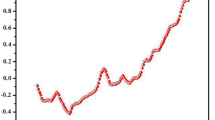Summary
The gas Chromatographic procedure can be used for the rapid and accurate determination of small amounts of nicotine in biological material. Application of the method proved successful in the determination of the disappearance of nicotine from mouse skin following the application of this alkaloid directly to the skin surface. A plot ofμg of nicotine per mg DNA or protein of mouse skin versus the time in hr following the application of nicotine showed that the biological half-life of nicotine in mouse skin over the first 6 hr is 1.2 hr.
Zusammenfassung
Das beschriebene Verfahren kann zur raschen und genauen Bestimmung geringer Mengen Nikotin in biologischem Material dienen. Das Verschwinden des Nikotins nach dessen Applikation auf die Hautoberfläche von Mäusen wurde damit untersucht. Trägt manμg Nikotin/mg DNS der Mäusehaut gegen die Zeit nach Applikation des Nikotins auf, so zeigt sich, daß die biologische Halbzeit des Nikotins in der Mäusehaut innerhalb der ersten 6 Stunden 1,2 Stunden beträgt.
Similar content being viewed by others
References
H. McKennis, Jr., The Disposition and Fate of Nicotine in Animals. In U. S. von Euler (ed.), Tobacco Alkaloids and Related Compounds, Oxford: Pergamon. 1965. pp. 53–74.
J. W. Gorrod and P. Jenner, The Metabolism of Tobacco Alkaloids. In N. J. Hayes (ed.), Essays in Toxicology, Vol. 6, New York: Academic. 1975. pp. 35–78.
F. Bock, Proc. Am. Assoc. Cancer Res.17, 2 (1976).
A. H. Beckett and E. J. Triggs, Nature211, 1415 (1966).
H. Schievelbein and K. Grundke, Z. analyt. Chem.237, 1 (1968).
I. E. Burrows, P. J. Corp, G. C. Jackson, and B. F. J. Page, Analyst96, 81 (1971).
P. F. Isaac and M. J. Rand, Nature236, 308 (1972).
C. Dumas, R. Badre, A. Vialu, J.-P. Cano, and R. Guillerm, Eur. J. Toxicol.8, 280 (1975).
L. Neelakantan and H. B. Kostanbauder, Analyt. Chemistry46, 452 (1974).
R. C. Mumpower and J. E. Kiefer, Tobacco Science165, 14 (1967).
M. P. Maskarinec, R. W. Harvey, and J. E. Caton, J. Analyt. Toxicol.2, 124 (1978).
O. H. Lowry, N. S. Rosebrough, A. L. Farr, and R. S. Randall, J. Biol. Chem.193, 265 (1951).
K. Burton, Biochem. J.62, 315 (1956).
S. E. Falkman, I. E. Burrows, R. A. Lundgren, and B. F. J. Page, Analyst100, 99 (1975).
J. Adir, R. P. Miller, and K. S. Rotenberg, Res. Commun. Chem. Pathol. Pharmacol.13, 173 (1976).
Author information
Authors and Affiliations
Rights and permissions
About this article
Cite this article
Carruthers, C., Neilson, A. A simplified procedure for the gas chromatographic determination of nicotine: Application of the method to mouse skin. Mikrochim Acta 74, 59–66 (1980). https://doi.org/10.1007/BF01196486
Received:
Revised:
Issue Date:
DOI: https://doi.org/10.1007/BF01196486




